Orford,
Alderton, Bawdsey
There is a definite emphasis on ex-Post Offices on this page covering
three towns/villages on the east coast between Felixstowe
and Aldeburgh.
Orford, Pump Street

 2017 images
2017 images
The empty shop at no. 55 Pump Street carries on the adjoining
house wall a typical enamel sign: 'ORFORD POST
OFFICE' in large and small caps. A picture frame has
been added at some point to add a touch of class.
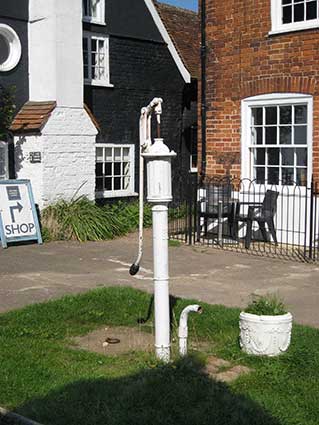
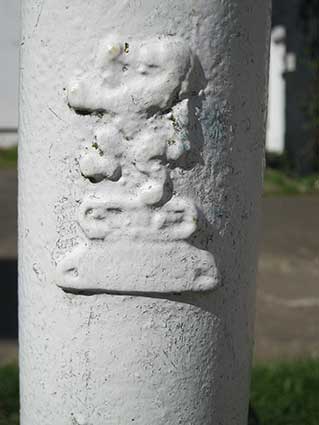
The town pump stands in a green space in Pump Street, close to
the post office and is well-maintained, but years of overpainting have
choked the casting mark.
We learn the following from the Village
pumps
website (see Links).
'Joseph Evans & Sons (Wolverhampton) Ltd, was founded in 1810 and
traded until about 1964, having been acquired by Newman Industries in
1944. The company had depots in Cardiff, Sheffield, Manchester, Glasgow
and Newcastle-on-Tyne, and examples of their pumps are scattered widely
around the UK and indeed further afield. The company used a number of
trademarks before settling on a lion rampant. From about 1890 they used
the lion rampant trademark on all of their pumps, with the word "LION"
written beneath. Many carry the message "Made in England", some add
"Evans Wolverhampton".'
On the Orford pump: 'Note that the spout is connected to the
working barrel below ground level and emerges separately, which
probably implies a lift and force pump. Essentially identical models
also seen at Perranwell, Cornwall and Lamerton, Devon.'
The Orford pump casting mark is clearly a lion rampant and the
cartouche below would have carried the word "LION' (unreadable).
However, the plate below this doesn't seem to have been lettered.
Alderton, The Street (B1083)
This small village on the Bawdsey road has a public house called
the Swan, close to the church. Tales of smuggling abound in the area
and the true story of Margaret Catchpole and her efforts to save her
lover, Will Laud – a smuggler, has much of its action around the
village of Alderton.
Just along the road from the pub and almost opposite the village shop
can be found this sign:
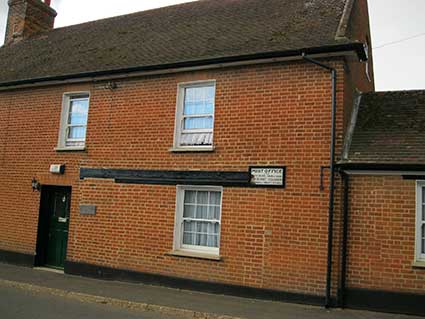
'POST OFFICE
FOR
MONEY ORDER, SAVINGS BANK
PARCEL POST, TELEGRAPH
INSURANCE AND ANNUITY BUSINESS'
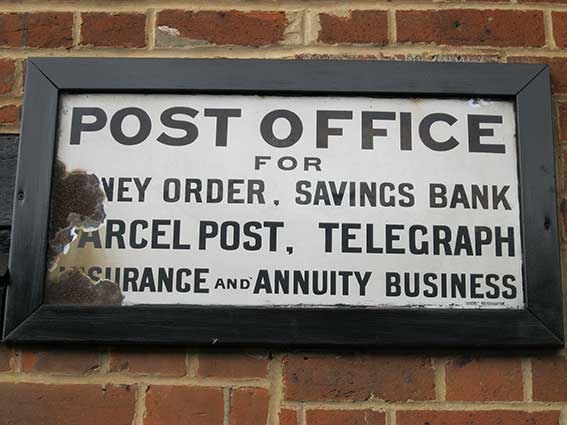
Money order
A money order is a payment order for a pre-specified amount of money.
As it is required that the funds be prepaid for the amount shown on it,
it is a more trusted method of payment than a cheque. The money order
system was established by a private firm in Great Britain in 1792 and
was expensive and not very successful. Around 1836 it was sold to
another private firm which lowered the fees, significantly increasing
the popularity and usage of the system. The Post Office noted the
success and profitability, and it took over the system in 1838. Fees
were further reduced and usage increased further, making the money
order system reasonably profitable. The only draw-back was the need to
send an advance to the paying post office before payment could be
tendered to the recipient of the order. This drawback was probably the
primary incentive for establishment of the Postal Order System on 1
January 1881.
The General Post Office
The story of the General Post Office dates back to its formation
under Charles II (1660). An organisation which grew over time, adapted
to new technologies (telegraph and telephone communication) with a
national network of post offices and sub-post offices. It even had an
early role in regulating broadcasting. Banking: The Post Office Savings
Bank was introduced in 1861, when there were few banks outside major
towns. By 1863, 2,500 post offices were offering a savings service.
Gradually more financial services were offered by post offices,
including government stocks and bonds in 1880, insurance and annuities
in 1888, and war savings certificates in 1916. In 1909 old age pensions
were introduced, payable at post offices. In 1956 a lottery bond called
the Premium Bond was introduced. In the mid-1960s the GPO was asked by
the government to expand into banking services which resulted in the
creation of the National Giro. In 1969, the Post Office Savings Bank
was transferred to the Treasury, and renamed National Savings. Splitting
up, privatisation and diminution of the Post Office continued after its
high point. The British Telecommunications Act, 1981 split off
that part to form British Telecom). As part of the Postal Services Act
2000, the businesses of the Post Office were transferred in 2001 to a
public limited company, 'Consignia plc', which was quickly renamed
Royal Mail Holdings plc. The government became the sole shareholder in
Royal Mail Holdings plc and its subsidiary Post Office Ltd. Finally, on
5 April 2007, the government published the Dissolution of the Post
Office Order 2007, under which the old Post Office statutory
corporation was formally abolished with effect from 1 May 2007.
All of this makes little mention of the importance of the post
office as a meeting-place, a communication centre for remote villages
and towns, giving identity within the national network. Huge numbers of
closures of post offices have resulted in their complete removal or, if
the inhabitants are fortunate, placing small counters within shops.
The emphasis, in the 21st century has been heavily on selling
and income generation for each sub-post office, rather than public
service. It is instructive that the last line of the sign advertises
'Insurance and Annuity Business' at the original Alderton Post Office.
It is encouraging that the house owner maintains this enamelled metal
sign, already starting to rust.
[Note also the 'Brown's of Ipswich' sign shown on our JBO lost signs page, spotted on a barn at
Buckanay Farm near Alderton village.]
Bawdsey wall box ('E VIII R')
The village of Bawdsey near
the mouth of the River Deben has another former sub-post office
shop. Connoisseurs make the pilgrimage to the main street to see the
Edward VIII
Ludlow wall-box. Edward VIII was King of the U.K. and Commonwealth for
less than a year and he
abdicated before his coronation, in order to marry the American
divorcee, Wallis
Simpson. He was later better known as the Duke of Windsor, living with
his wife in Paris. The story
has links to the County Hall court in St
Helens Street, Ipswich where
Simpson's decree nisi from
her second husband was granted and a house (now
demolished) at Felixstowe Undercliff
where she hid away from the press
during this legal process. Coins minted with the new king's profile and
wall-boxes bearing his crest are very rare. This information came from
a Flickr image of
the box: 'Following the Abdication Crisis in late 1936, resentment and
bad feeling led to the removal or exchange of many of the doors of
these boxes. Today none exists in their original form, save for one
Ludlow wall-box at Bawdsey in Suffolk. Unfortunately the original
enamel plate on this box was stolen and the plate seen on the box today
is a modern replica. According to the guidebook of St Mary's church,
uniquely the Bawdsey box has the cipher of the King's Crown and
initials that appear on no other post-box.'
'E...R
E VIII R
POST OFFICE
LETTER BOX.
NOTICE: LETTERS CONTAINING COIN,
PAPER MONEY OR JEWELLERY
SHOULD NOT BE POSTED IN THIS BOX,
BUT SHOULD BE REGISTERED.'
It would be easy to walk
past this box and, in glancing at it, assume that it was made in the
reign of Queen Elizabeth II, as the Roman numerals 'VIII' below the
royal crown are inconspicuous.
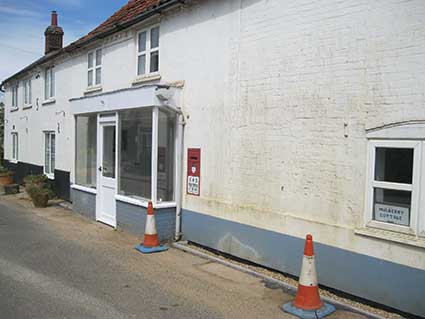
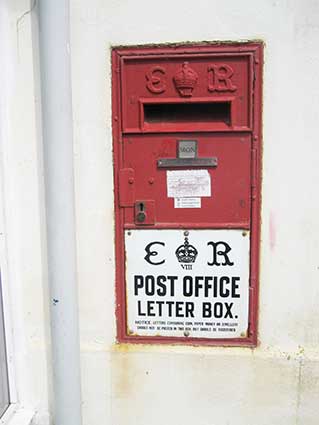 2019 images
2019 images
See our Street
furniture page for more about Ludlow post boxes.
Home
Return to Historic Lettering from outside
Ipswich
Please email any comments and contributions by clicking here.
Search Ipswich
Historic Lettering
©2004 Copyright
throughout the Ipswich
Historic Lettering site: Borin Van Loon
No reproduction of text or images without express
written permission

 2017 images
2017 images




 2019 images
2019 images